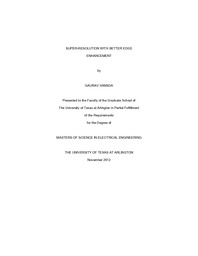
ATTENTION: The works hosted here are being migrated to a new repository that will consolidate resources, improve discoverability, and better show UTA's research impact on the global community. We will update authors as the migration progresses. Please see MavMatrix for more information.
Show simple item record
| dc.contributor.author | Hansda, Gaurav | en_US |
| dc.date.accessioned | 2013-03-20T19:10:07Z | |
| dc.date.available | 2013-03-20T19:10:07Z | |
| dc.date.issued | 2013-03-20 | |
| dc.date.submitted | January 2012 | en_US |
| dc.identifier.other | DISS-11960 | en_US |
| dc.identifier.uri | http://hdl.handle.net/10106/11489 | |
| dc.description.abstract | Super resolution image reconstruction is a promising technique of digital imaging which attempts to generate a raster image with a higher resolution than its source. The source can consist of one or more images or frames. This thesis focuses on single-frame super-resolution i.e. the source is a single raster image. Changing the resolution directly refers to resampling the image. Specific algorithms have been designed for scaling up, scaling down and rotating images that deliver high quality results. Process of scaling up or super-resolution is the primary focus of this thesis, which in contrast scaling down or rotating deals with the problem of increasing the amount of pixels or, more general, data. In comparison to various other image enhancement techniques, super-resolution image reconstruction technique not only improves the quality of under-sampled, low-resolution images by increasing their spatial resolution but also attempts to filter out distortions.The Iterative back-projection (IBP) is a classical super-resolution method with low computational complexity that can be applied in real time applications. However, it often produces many artifacts especially along the strong edges. To reduce these jaggy artifacts, this thesis proposes a novel approach to single image super-resolution image reconstruction. First, an image up-sampling scheme is implemented which takes the advantage of bilateral filtering as well as mean shift image segmentation. This produces a better smoothed image. Then, a complex shock filter is used to enhance strong edges in the initial up-sampling result and obtain an intermediate high-resolution image. Complex shock filters are less sensitive to noise than other shock filters. After that, a reconstruction constraint on the high-resolution image is applied, so that fine details can be suppressed in the back projection step. IBP is the state of art method for this. Finally, as a post-processing step on the reconstructed image, the structural content of low resolution image and the correlation among the pixels with similar structure are learned and employed on the reconstructed image to further stop across-edge propagation. The experimental results proved that this proposed method can remove the artifacts subjectively and obtain sharp edges in visual perception. Comparing this algorithm with several other state-of-the-art image super-resolution algorithms shows that this approach performs better in terms of both qualitatively and quantitatively (peak signal-to-noise ratio and mean square error). | en_US |
| dc.description.sponsorship | Rao, Kamisetty R. | en_US |
| dc.language.iso | en | en_US |
| dc.publisher | Electrical Engineering | en_US |
| dc.title | Super-resolution With Better Edge Enhancement | en_US |
| dc.type | M.S. | en_US |
| dc.contributor.committeeChair | Rao, Kamisetty R. | en_US |
| dc.degree.department | Electrical Engineering | en_US |
| dc.degree.discipline | Electrical Engineering | en_US |
| dc.degree.grantor | University of Texas at Arlington | en_US |
| dc.degree.level | masters | en_US |
| dc.degree.name | M.S. | en_US |
Files in this item
- Name:
- Hansda_uta_2502M_11960.pdf
- Size:
- 2.817Mb
- Format:
- PDF
This item appears in the following Collection(s)
Show simple item record


